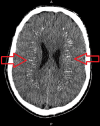Fahr's Syndrome: A Rare Case Presentation
- PMID: 38022014
- PMCID: PMC10676739
- DOI: 10.7759/cureus.47812
Fahr's Syndrome: A Rare Case Presentation
Abstract
Idiopathic basal ganglia calcification (IBGC), also known as Fahr's disease, is a rare neurological disorder characterized by metabolic, biochemical, neuroradiological, and neuropsychiatric alterations resulting from symmetrical and bilateral intracranial calcifications. In most cases, an autosomal dominant pattern of inheritance and genetic heterogeneity is observed. Neuropsychiatric symptoms with movement disorders account for 55% of the manifestations of this disease. In this report, we present the case of a 42-year-old Pakistani male who presented to the emergency department with a sudden onset of generalized tonic muscle contractions. His medical history revealed progressive cognitive impairment, and he had a history of taking oral calcium supplements. Initial laboratory investigations showed hypocalcemia with normal magnesium and phosphate levels, while his parathyroid hormone levels were low. The interictal electroencephalogram was normal, and CT imaging of the brain without contrast revealed bilateral symmetrical dense calcifications in the basal ganglia, thalami, periventricular area, corona radiata, centrum semiovale, and dentate nucleus of the cerebellum, suggestive of Fahr disease. Intravenous calcium gluconate was administered in the emergency department, leading to an improvement in the patient's symptoms. The diagnosis of IBGC with relevant symptoms was confirmed through laboratory values and characteristic features observed in the CT examination.
Keywords: basal ganglia; calcium deposits; computed tomography (ct ); hypoparathyriodism; seizure disorders.
Copyright © 2023, Wazir et al.
Conflict of interest statement
The authors have declared that no competing interests exist.
Figures
References
-
- Vadera Vadera, S. and Di Muzio, B. B., 2011 2011. Normal intracranial calcifications. [ Oct; 2022 ]. 2022. https://radiopaedia.org/articles/normal-intracranial-calcifications?lang=us https://radiopaedia.org/articles/normal-intracranial-calcifications?lang=us
-
- Fahr’s disease in a patient presenting with status epilepticus. Khalid S, Khan SA, Khan AH, Muhammad G, Khan AA. J Ayub Med Coll Abbottabad. 2020;32:280–282. - PubMed
-
- Molecular mechanism of idiopathic basal ganglia calcification (Article in Chinese) Wang C, Xu X, Li LL, et al. https://pubmed.ncbi.nlm.nih.gov/26353387/ Yi Chuan. 2015;37:731–740. - PubMed
Publication types
LinkOut - more resources
Full Text Sources


